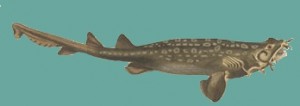Spotted wobbegong sharks demonstrate social clique behaviour
News Release
Macquarie University, Sydney Australia
02. May 2016
– – – – – – – – – – – –
 New research suggests that the spotted wobbegong shark aggregates in ‘social’ groups, as opposed to previous assumptions that shark groupings were chance occurrences influenced by available food, mates or other environmental factors.
New research suggests that the spotted wobbegong shark aggregates in ‘social’ groups, as opposed to previous assumptions that shark groupings were chance occurrences influenced by available food, mates or other environmental factors.
The study, led by Macquarie University, used the Integrated Marine Observing System (IMOS) network to observe the movements and associations of individual sharks found in Cabbage Tree Bay Aquatic Reserve.
The researchers found that the sharks did not associate randomly. Rather, some sharks were found together as preferred partners, even in different areas of the reserve, while others never associated.
“If these aggregations are not random but in fact reflect more complex social relationships, then the impacts from historical fishing may also not be random, and may have continuing consequences,” said lead author Nicolette Armansin.
“Wobbegongs are large bottom dwelling ambush predators often found in large groups close to shore where they have been heavily exploited – most people would have encountered one was at their local fish and chip shop.
“Our study points to potential unintended consequences of fishing on shark populations, as instead of randomly catching individuals, fishing may selectively remove important members of social networks, with as yet unknown consequences on the stability of the population.”
Most important to the researchers was the realisation that the groupings were not sex or age related, which ruled out the possibility that the groupings were simply a case of younger animals grouping together for safety. Interestingly, they also found that a preference for the same resting habitat did not explain the patterns of their associations.
“What we found was that sharks were interacting in a much more complex way than we predicted,” said Macquarie researcher Professor Rob Harcourt.
“Social behaviour might be expected in sharks that feed together on large schools of fish, but the existence of these associations in even bottom dwelling predators that individually ambush their prey, points to a much higher level of social complexity than previously imagined, and to possible common evolutionary mechanisms across multiple animal groups.
“Like mammals, birds and reptiles, it appears that sharks inhabit a far richer social world than we would have imagined.”
Source: Macquarie University
Related Scientific Paper:
N.C. Armansin, K.A. Lee, C. Huveneers, R.G. Harcourt
Integrating social network analysis and fine-scale positioning
to characterize the associations of a benthic shark
Animal Behaviour, Volume 115, May 2016, doi:10.1016/j.anbehav.2016.02.014
—
